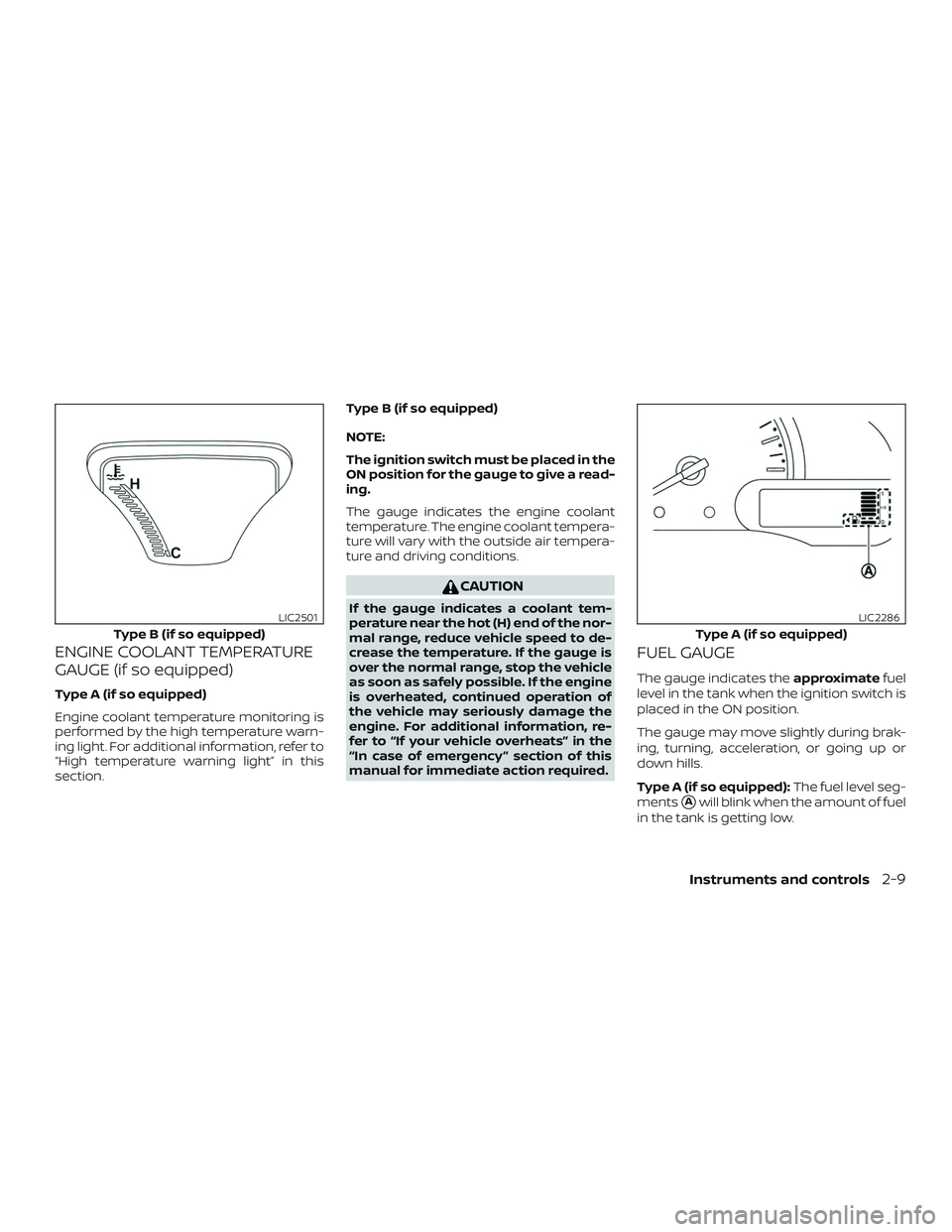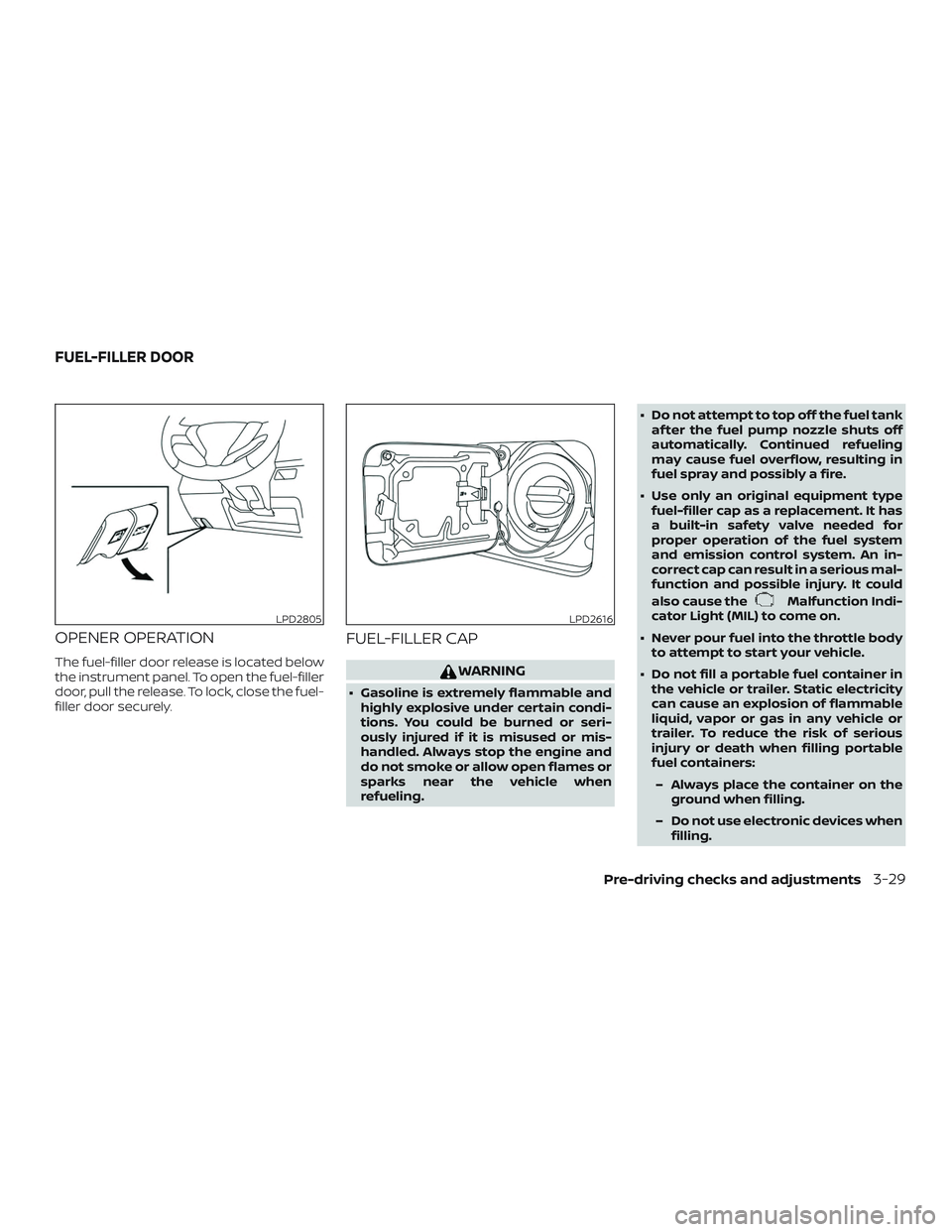Page 83 of 372
17. Ignition switch (if so equipped)(P. 5-9)
Push-button ignition switch
(if so equipped) (P. 5-11)
18. Cruise control switches
(if so equipped) (P. 5-24)
19. Tilt steering (P. 3-31)
20. Audio control switches (P. 4-43) Bluetooth® Hands-Free Phone
System switches (P. 4-47)
21. Vehicle Dynamic Control (VDC) OFF
switch (P. 2-29)
22. Fuel-filler door release lever
(P. 3-29)
Hood release lever (P. 3-26)
23. Electronic outside rearview mirror
control switch (P. 3-33)
Refer to the page number indicated in
parentheses for operating details.
1. Tachometer
2. Speedometer
3. Fuel gauge
4. OdometerTwin trip odometer
Trip computer 5. Continuously Variable Transmission
(CVT) position indicator
6. Instrument brightness control
knob
7. Change/reset button
Type A (if so equipped)
LIC3131
METERS AND GAUGES
Instruments and controls2-3
Page 84 of 372
CAUTION
∙ To clean the meter lens, use a sof tcloth, dampened with water. Never
use a rough cloth, alcohol, benzine,
thinner or any kind of solvent or paper
towel with a chemical cleaning agent.
They will scratch or cause discolor-
ation to the lens.
∙ Do not spray any liquid such as water on the meter lens. Spraying liquid
may cause the systems to
malfunction.
1. Tachometer
2. Temperature gauge
3. Odometer Twin trip odometer
Trip computer Outside air temperature (if so
equipped)
4. Fuel gauge
5. Speedometer
6. Change/reset button
Type B (if so equipped)
LIC2146
2-4Instruments and controls
Page 86 of 372
Odometer/Twin trip odometer
The odometer/twin trip odometer is dis-
played when the ignition switch is placed in
the ON position.
The odometer
�1records the total dis-
tance the vehicle has been driven.
The twin trip odometer
�2records the dis-
tance of individual trips. Changing the display
Press the change/reset button
�3to
change the display as follows:
Odometer (ODO) →Trip
→Trip→Instant fuel consumption →Average fuel
consumption →Distance to empty (cruis-
ing range) →Odometer (ODO) Resetting the trip odometer
Pushing the TRIP RESET switch
�3for more
than 1 second resets the currently dis-
played trip odometer to zero.
Average fuel economy and distance to
empty information is also available. For ad-
ditional information, refer to “Trip com-
puter” in this section.
Type A (if so equipped)
LIC3305
Type B (if so equipped)
LIC2139
2-6Instruments and controls
Page 87 of 372
Loose fuel cap warning message
Push the reset button�Afor more than
1 second to reset the LOOSE FUEL CAP
warning message af ter the fuel cap has
been tightened. For additional information,
refer to “Fuel-filler cap” in the “Pre-driving
checks and adjustments” section of this
manual.
Check tire pressure warning
message (if so equipped)
The CHECK TIRE PRES warning message is
displayed when the low tire pressure warn-
ing light is illuminated and low tire pressure
is detected. Check and adjust the tire pres-
sure to the recommended COLD tire pres-
sure shown on the Tire and Loading Infor-
mation label. The CHECK TIRE PRES
warning message can be turned off using
the reset button
�Aon the meter, the low
tire pressure warning light will not be
turned off.
Type A (if so equipped)
LIC3306
Type B (if so equipped)
LPD2025
Type A (if so equipped)
LIC3307
Instruments and controls2-7
Page 89 of 372

ENGINE COOLANT TEMPERATURE
GAUGE (if so equipped)
Type A (if so equipped)
Engine coolant temperature monitoring is
performed by the high temperature warn-
ing light. For additional information, refer to
“High temperature warning light” in this
section.Type B (if so equipped)
NOTE:
The ignition switch must be placed in the
ON position for the gauge to give a read-
ing.
The gauge indicates the engine coolant
temperature. The engine coolant tempera-
ture will vary with the outside air tempera-
ture and driving conditions.
CAUTION
If the gauge indicates a coolant tem-
perature near the hot (H) end of the nor-
mal range, reduce vehicle speed to de-
crease the temperature. If the gauge is
over the normal range, stop the vehicle
as soon as safely possible. If the engine
is overheated, continued operation of
the vehicle may seriously damage the
engine. For additional information, re-
fer to “If your vehicle overheats” in the
“In case of emergency ” section of this
manual for immediate action required.
FUEL GAUGE
The gauge indicates the
approximatefuel
level in the tank when the ignition switch is
placed in the ON position.
The gauge may move slightly during brak-
ing, turning, acceleration, or going up or
down hills.
Type A (if so equipped): The fuel level seg-
ments
�Awill blink when the amount of fuel
in the tank is getting low.
Type B (if so equipped)
LIC2501
Type A (if so equipped)
LIC2286
Instruments and controls2-9
Page 90 of 372

Type B (if so equipped):The low fuel warn-
ing light
�Awill turn on when the amount of
fuel in the tank is getting low.
Refill the fuel tank before the gauge reg-
isters 0 (Empty).
The
indicates that the fuel-filler
door is located on the driver’s side of the
vehicle.
CAUTION
∙ If the vehicle runs out of fuel, thecheck engine light may come on. Re-
fuel as soon as possible. Af ter a few
driving trips, the
light should
turn off. If the light remains on af ter a
few driving trips, have the vehicle in-
spected. It is recommended that you
visit a NISSAN dealer for this service.
∙ For additional information, refer to “Malfunction Indicator Light (MIL)” in
this section.
DISTANCE TO EMPTY (DTE)
Displays the estimated distance the ve-
hicle can be driven before refueling. The
value is calculated based on recent fuel
economy, the amount of fuel remaining in
the fuel tank, and the actual fuel consump-
tion.
Changes in driving patterns or conditions
can cause the DTE value to vary. As a result,
the value displayed may differ from the ac-
tual distance that can be driven.
DTE display will change to “---” when the
fuel level in the tank is getting low, prior to
the fuel gauge reaching 0 (Empty). NOTE:
∙ The DTE value af ter refill is estimated
based on recent fuel economy and
amount of fuel added.
∙ If a small amount of fuel is added, or
the ignition is on during refueling, the
display may not be updated.
∙ Conditions that affect the fuel
economy will also affect the esti-
mated DTE value (city/highway driv-
ing, idle time, remote start time, ter-
rain, seasonal weather, added vehicle
weight, added deflectors, roof racks,
etc.).Type B (if so equipped)
LIC2287
2-10Instruments and controls
Page 91 of 372

TRIP COMPUTER
When the ignition switch is placed in the ON
position, modes of the trip computer can
be selected by pushing the change/reset
button
�Aon the instrument panel located
near the speedometer. The following
modes can be selected in the display
�B:
∙ Odometer
∙ Trip A
∙ Trip B
∙ Instant fuel consumption ∙ Average fuel consumption
∙ Distance to empty
∙ Outside air temperature (if so equipped)
Odometer
The odometer records the total distance
the vehicle has been driven.
Trip A
Measures the distance of one specific trip.
Trip B
Measures the distance of a second specific
trip.
Instant fuel consumption
The instant fuel consumption mode shows
the instant fuel economy. The display up-
dates instantly when driving.
Average fuel consumption (mpg
or l (liter)/100 km)
The average fuel consumption mode
shows the average fuel consumption since
the last reset. Resetting is done by pressing
the trip or change button for more than
approximately 1 second. The display is up-
dated every 30 seconds. At about the first
1/3 mi (500 m) af ter a reset, the display
shows (----).Type A (if so equipped)
LIC2470
Type B (if so equipped)
LIC2138
Instruments and controls2-11
Page 147 of 372

OPENER OPERATION
The fuel-filler door release is located below
the instrument panel. To open the fuel-filler
door, pull the release. To lock, close the fuel-
filler door securely.
FUEL-FILLER CAP
WARNING
∙ Gasoline is extremely flammable andhighly explosive under certain condi-
tions. You could be burned or seri-
ously injured if it is misused or mis-
handled. Always stop the engine and
do not smoke or allow open flames or
sparks near the vehicle when
refueling. ∙ Do not attempt to top off the fuel tank
af ter the fuel pump nozzle shuts off
automatically. Continued refueling
may cause fuel overflow, resulting in
fuel spray and possibly a fire.
∙ Use only an original equipment type fuel-filler cap as a replacement. It has
a built-in safety valve needed for
proper operation of the fuel system
and emission control system. An in-
correct cap can result in a serious mal-
function and possible injury. It could
also cause the
Malfunction Indi-
cator Light (MIL) to come on.
∙ Never pour fuel into the throttle body to attempt to start your vehicle.
∙ Do not fill a portable fuel container in the vehicle or trailer. Static electricity
can cause an explosion of flammable
liquid, vapor or gas in any vehicle or
trailer. To reduce the risk of serious
injury or death when filling portable
fuel containers:
– Always place the container on the ground when filling.
– Do not use electronic devices when filling.
LPD2805LPD2616
FUEL-FILLER DOOR
Pre-driving checks and adjustments3-29